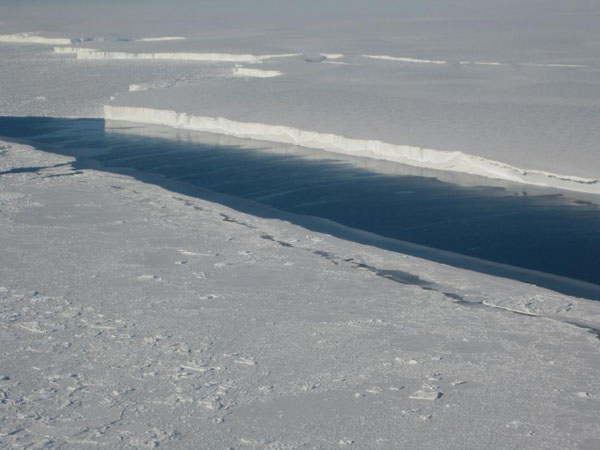Calving front of an ice shelf in West Antarctica. This image was taken during the 2012 Antarctic campaign of NASA's Operation IceBridge, a mission that provided data for the new ice shelf study. Image via NASA/GSFC/Jefferson Beck
Ocean waters melting the underbelly of the Antarctic’s ice shelves are now thought to be responsible for most of the continent’s ice shelf mass loss, that’s according to a new study from NASA and university researchers.
Conventional wisdom on Antarctic mass loss is that ice shelves – the floating extensions of glaciers that empty into the sea – lose ice by shedding icebergs.
A new study that has been published today in the journal Science claims, however, that many of Antarctica’s ice shelves are melting from the bottom up.
To date, scientists have studied the rates of melting from underneath (known as basalt melt) of individual ice shelves. NASA claims this is the first comprehensive survey of all Antarctic ice shelves.
Warm ocean currents
The study found that 55pc of all Antarctic ice shelf mass loss between 2003 to 2008 happened as a result warm ocean currents melting the ice shelves from below.
“The traditional view on Antarctic mass loss is it is almost entirely controlled by iceberg calving,” said Eric Rignot, the lead author of the study who works at NASA’s Jet Propulsion Laboratory and at the University of California, Irvine.
“Our study shows melting from below by the ocean waters is larger, and this should change our perspective on the evolution of the ice sheet in a warming climate,” he said.
About 60pc of the planet’s fresh water is locked into Antarctica’s massive ice sheet.
The study found basal melting is distributed unevenly around the continent. The three giant ice shelves of Ross, Filchner and Ronne, which make up two-thirds of the total Antarctic ice shelf area, accounted for only 15pc of basal melting.
According to the researchers, this study could help scientists improve projections of how the Antarctic ice sheet will respond to a warming ocean and contribute to rises in sea levels.
Using reconstructions of ice accumulation, satellite and aircraft readings of ice thickness, and changes in elevation and ice velocity, the scientists were able to determine how fast ice shelves melt. They then compared the mass lost with the amount released by the splitting icebergs.

The ice front of Venable Ice Shelf, West Antarctica, in October 2008. Image via NASA/JPL-Caltech/UC Irvine
In total, Antarctic ice shelves lost 1,325trn kilograms (2,921trn pounds) of ice per year between 2003 and 2008 through basal melt, while iceberg formation accounted for 1,089trn kilograms (2,400trn pounds) of mass loss each year.
The scientists said basal melt could have a greater impact on ocean circulation than glacier calving. That’s because icebergs slowly release melt water as they drift away from the continent.
“Changes in basal melting are helping to change the properties of Antarctic bottom water, which is one component of the ocean’s overturning circulation,” said one of the study’s authors Stan Jacobs, an oceanographer at Columbia University’s Lamont-Doherty Earth Observatory.
He said that in some areas it also impacts ecosystems by driving coastal upwelling.
Shedding ice
The researchers also compared the rates at which the ice shelves are shedding ice to the speed at which Antarctica itself is losing mass.
“Ice shelf melt doesn’t necessarily mean an ice shelf is decaying; it can be compensated by the ice flow from the continent,” said Rignot.
“But in a number of places around Antarctica, ice shelves are melting too fast, and a consequence of that is glaciers and the entire continent are changing, as well.”
Check out our recent interview with NASA scientist Dr Claire Parkinson, who has been researching sea ice since 1978.